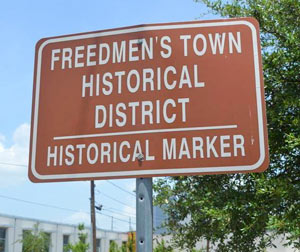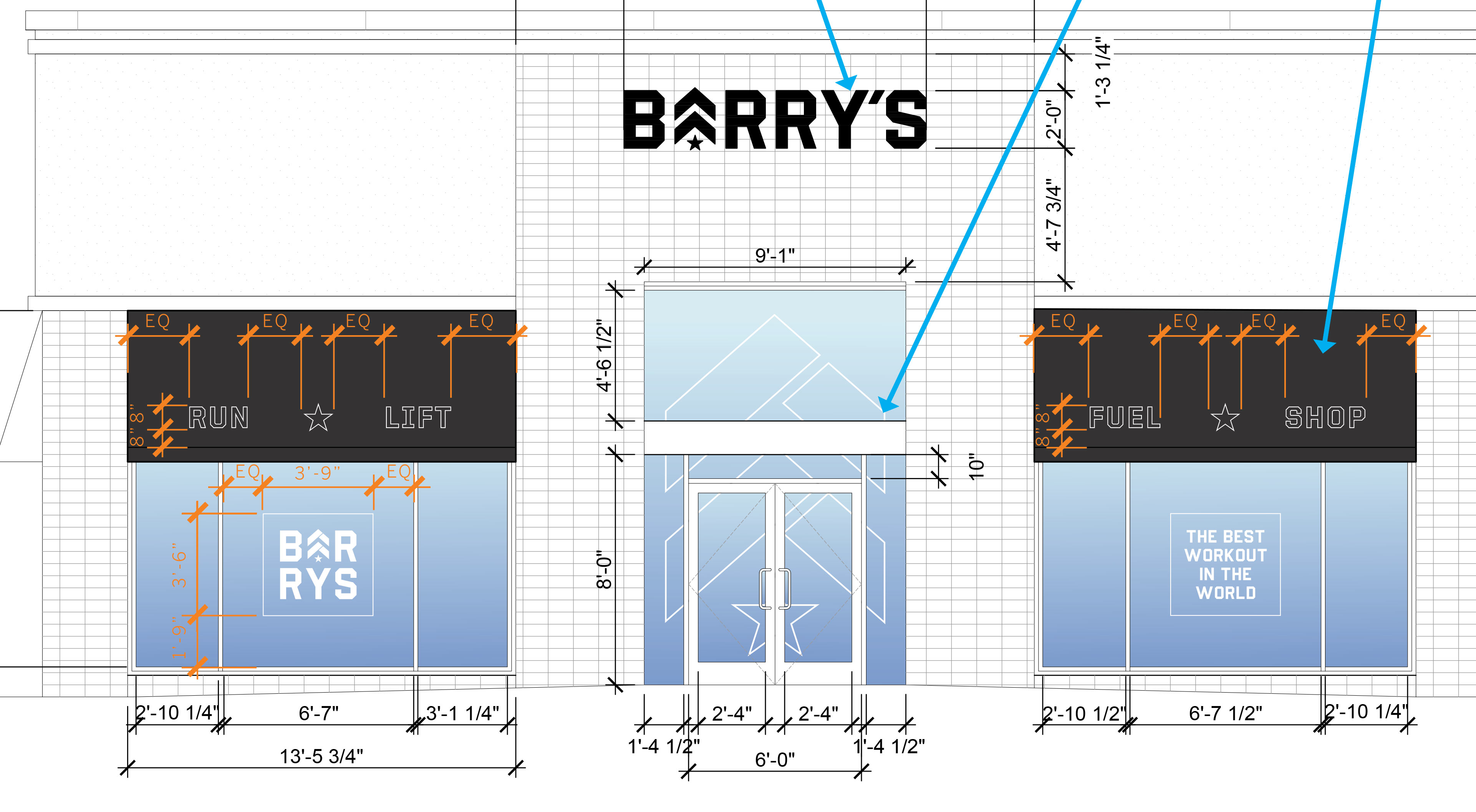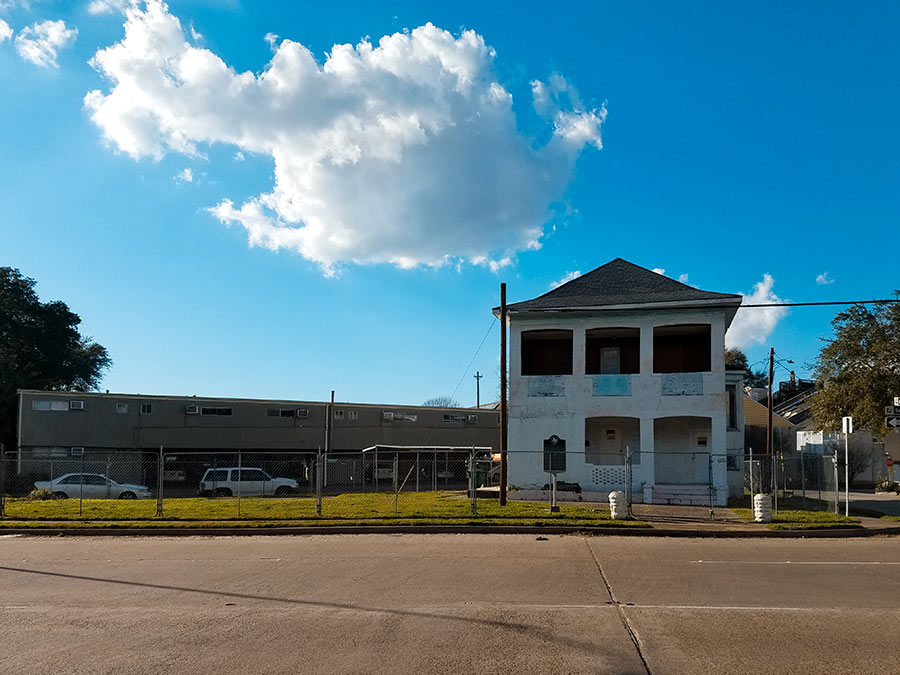CITY WANTS TO CREATE HISTORIC DISTRICT TO PROTECT WHAT’S LEFT OF FREEDMEN’S TOWN HISTORIC DISTRICT  Following last month’s sudden brick relocation incident, Mayor Turner has announced a plan to make a plan to create a “cultural district in Freedmen’s Town — one that would preserve historic churches, schools, and homes,” as Andrew Schneider describes it this week. A section of the Fourth Ward roughly bounded by W. Gray, W. Dallas, Genessee, and Arthur streets has been listed in the National Register of Historic Places since 1985 as the Freedmen’s Town Historic District — but that national designation didn’t provide much local protection to the area’s architecture, and many of the buildings listed in the district’s nomination form to the register have since been demolished. Archi-historian Stephen Fox told Claudia Feldman back in February that a city of Houston historic district designation, however, would be different; Fox noted that “it might require gerrymandering to pick up the proper concentration of historic buildings. But it could be done.” [Houston Public Media and Houston Chronicle; previously on Swamplot] Photo of Freedmen’s Town Historic District sign: Freedmen’s Town Preservation Coalition
Following last month’s sudden brick relocation incident, Mayor Turner has announced a plan to make a plan to create a “cultural district in Freedmen’s Town — one that would preserve historic churches, schools, and homes,” as Andrew Schneider describes it this week. A section of the Fourth Ward roughly bounded by W. Gray, W. Dallas, Genessee, and Arthur streets has been listed in the National Register of Historic Places since 1985 as the Freedmen’s Town Historic District — but that national designation didn’t provide much local protection to the area’s architecture, and many of the buildings listed in the district’s nomination form to the register have since been demolished. Archi-historian Stephen Fox told Claudia Feldman back in February that a city of Houston historic district designation, however, would be different; Fox noted that “it might require gerrymandering to pick up the proper concentration of historic buildings. But it could be done.” [Houston Public Media and Houston Chronicle; previously on Swamplot] Photo of Freedmen’s Town Historic District sign: Freedmen’s Town Preservation Coalition





So which buildings does this include? The public housing apartments or city-owned, remodeled houses? The “grocery store” hang-out-cum-drug-front? One of the many dilapidated “historic” shotgun shacks that are the urban equivalent of the rural pickup truck on blocks in the front yard? They’re about a year too late to get the abandoned-speakeasy-turned-druggie-crash-pad. It already burned down.
seems kinda late
This pretty much fits the textbook example of “closing the barn door after the horse already left”.
.
Plus, the preservation designation doesn’t really do much if past history is to be used as a guide. Our local designations are a mere speed bump in a developer’s plan.
A little late for that. There are so many new homes and townhomes, and vacant lots, in the area that there is almost no historic character left. It’s a prime area for redevelopment anyway–might as well let the developers finish the job and do it right so it’s not just a hodgepodge.
Need to run a bulldozer though this dump. Nothing but drugs and gangs.
Do it, mayor!
While the area does have a lot of historic significants it’s long gone and before the new development was over run by lots of crimeand ha just been a sore spot in a nice area of town. I believe they should preserve what buildings they can especially the brick streets but anything more than that wouldn’t make sense.
1) Buy a block (maybe the vacant one on west gray, and the blocks are small).
2) move all extant historical structures to said block and make it a park, public space for outdoor events
3) Rehab brick streets
– anything beyond this in the name of historical preservation is in name only
After the neighborhood is semi-cleaned and we have sucked up the worst years dealing with gangs , break-ins and drug dealing. The City is ready to designate this neiborhood as historic and stop the re-development efforts of several investors, builders and developers. It is unfair!!!!! The City has done nothing about the drug problem on properties like 1616 Ruthven (privately demolished and where a person died of overdose) 1501 Ruthven(privately demolished and where a bunch of squaters gather to get high and that eventually they burned down) and has done nothing on the Robin and Mathews grocery store where a guy was murdered on July 4th. The City should start and focus the efforts on the security of many kids and families living in the neighborhood and let the developers keep doing the job.
Preserving historic landmarks such as churches, streets and homes is a good a idea, but they City should come up with a good plan. Churches dont have enough parking and they sometimes they block entire streets with parked cars. The brick street is been in a fight for so many years and it is in deplorable conditions. It is a shame and sad driving around these streets. Look at Sawyer Heights after the historic designation, the redevelopment stop and now it is just left with are a bunch of expensive old properties that nobody wants to purchase becuase they just need to remodel.
I hope they just not designate the entire area as hiatoric, but only the landmark properties that are in good shape.
I agree with Cindy’s comment. This isn’t just a Houston problem, this is happening all over the country. A historic area being abandoned by cities and local government, only for them to get so bad that people figure the only thing worth doing is demolishing it all, displacing families, erasing the history, and gentrifying the area so it can “finally look nice”. This was all done on purpose.
Sad that it’s taken so long, but I’m glad that it will happen now. I hope this will bring attention and funds to the ongoing work in Freedman’s Town. There are still some fine buildings there and lots of important Houston history.
Freedmen’s Town “is” an historic district. It is not too late for the City to honor the 40 block foot-print, boundaries of the original National Register Historic District of Freedmen’s Town, “without chopping it up” in order to accommodate a Local Preservation scheme that changes with every new Mayor. The City of Houston covers 640 sq. miles, and has only 2 sq. miles of historic districts, and only 1 sq. mile of an African Heritage National Register Historic District. Surely the City has the capacity to protect 1 sq. mile of a 19th Century, African Heritage National Register Historic District?!? Developers can look in the 637 sq. miles of land on which to build high density housing. The permanent jobs created and the tourism revenue from a 1 sq mile of a carefully preserved and restored National Register historic museum district of Freedmen’s Town would far surpass income from the property taxes… even if every inch of the 40 blocks is covered with concrete and multi family rentals. Since 1985, each administration has violated federal laws, put policies in place for the “taking” of properties, displacing families, and for the demolition of properties including churches. Each time the City has used federal, state, and/or local tax dollars to “plan” Freedmen’s Town, the end results have been – erasure and shrinking of the Nat. Register Historic District.
Now is the opportunity for the City to preserve the 40 block foot-print of the NRH Freedmen’s Town Museum District by stopping the issue of new construction permits, stop issuing demolition permits, by installing all electric, water, gas, and sani-sewer lines, using appropriate trenchless methods, under sidewalk easements and rerouting, in order to “Avoid Harm to the Cultural Resources” (the historic roadways of 1866, including 2 miles of brick streets, and archaeology sites).
Attracting International Tourism to Houston should be the highest priority. Creating permanent jobs in the tourism industry is far more beneficial than the few short term construction jobs.
Gerrymandering is tokenism. Every remaining historic house, the 6 historic churches, the green spaces, archaeology sites, and every roadway in the 40 block Nat. District should have a separate City Protected Classification that is permanent and not based upon the criteria of the regular City Preservation scheme. How about an executive order? Freedmen’s Town Museum District in the City Charter? No build zone? Green space, historic homes, churches, cemeteries, sacred sites, roadways, African American Library, museum houses, schools, trolley tours, a walkable community!